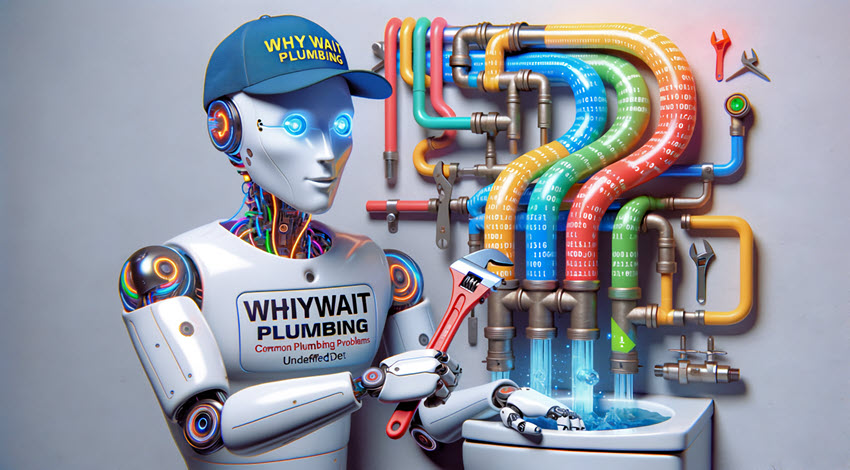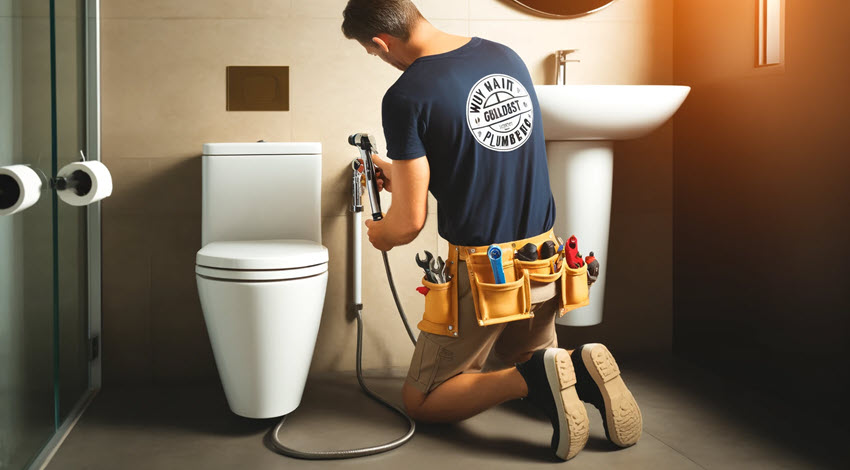
Unleashing Plumbing AI: A Transformation Like Never Before
Plumbing AI: Evolving with Plumbing Diagnostics
Plumbing AI has existed in various forms for at least twenty years. However, we did not call it AI or artificial intelligence; it was just part of our industry’s evolution.
Think of infrared detectors, drain cameras, iPhone camera technology, leak detection equipment, water monitoring, Nearmap and so on. These developments have evolved from medical technology advancements, enabling us to look inside pipes like doctors insert cameras into our bodies.
Technology is advancing rapidly, touching every part of our lives, and the plumbing industry is no exception. Plumbing AI is the latest innovation transforming how we manage and maintain our plumbing systems.
At Whywait Plumbing, we’re not just following the trend. We’re setting it, leading the way in the AI revolution of the plumbing industry.
Our commitment to adopting cutting-edge technology ensures that our clients receive the best service possible. Let’s examine how AI is changing the plumbing landscape.
Predictive Maintenance: Preventing Problems Before They Arise
One of the most significant benefits of plumbing AI is predictive maintenance. With AI, we can predict plumbing issues before they become serious problems, saving homeowners from emergencies and businesses from costly repairs.
AI systems analyse data from various sensors and historical patterns to identify potential leaks, pipe corrosion, or blockages. This means that AI can predict plumbing issues before they become serious problems.
This means fewer emergencies and costly repairs for homeowners. Predictive maintenance can save significant downtime and expenses for businesses, ensuring smooth operations.
Just imagine the peace of mind of addressing a small leak before it turns into a flood or replacing a corroding pipe before it bursts. The potential savings are immense, both in terms of money and hassle. Predictive maintenance saves you from emergencies and gives you a sense of control over your plumbing systems.
At Whywait Plumbing, we don’t just wait for problems to occur. Proactive solutions are a cornerstone of our services. We can detect even the most minor leaks using AI-driven tools before they become significant issues. For example, our Real-Time Water Monitoring, which we have been using since 2011, uses advanced AI technology to address potential problems before they cause significant damage.
Preventative Maintenance is Not Predictive Maintenance
The term “Preventative Maintenance” is creating ongoing perception issues for plumbers.
Clients increasingly perceive that if we check the hot water system, for example, it’s all good to go for the following year. The reality is that everything was good when we checked it out and tested it.
It’s important to note that plumbing AI predictive maintenance is frequently here and now. It will not prevent failure but tell us when it occurs.
We already know from experience that valves have a limited operational lifespan, but most clients only want them replaced once they fail. Most clients want reactive maintenance, not preventative maintenance, as it’s commonly perceived.
Smart Plumbing Systems: The Future of Home Automation
AI is making our homes smarter. Smart plumbing systems, such as AI-powered mixer taps, showers, and toilets, are becoming more common.
These devices offer unparalleled convenience and help conserve water, making your home more efficient and comfortable. For instance, smart mixer taps can detect when your hands are under them and turn on automatically, reducing water waste. Smart showers can remember your preferred temperature settings and even shut off the water while you lather to save water, making your home more efficient and comfortable.
These are all available now, although the uptake into Australian homes could be faster. We are mainly installing smart sensor taps in public toilet facilities.
Integration with Home Automation
Imagine controlling your shower temperature with a voice command or having a toilet that automatically adjusts its water usage based on need. These innovations are not just about luxury but efficiency and sustainability. Adopting smart plumbing systems makes your life more convenient and contributes to water conservation and a sustainable future.
Smart mixer taps, for instance, can detect when your hands are under them and turn them on automatically, reducing water waste and making your daily routines more convenient. Smart showers can remember your preferred temperature settings and even shut off the water while you lather to save water, making your home more efficient and comfortable.
Our team at Whywait Plumbing is excited about the possibilities of smart plumbing systems. We offer installation services for smart plumbing fixtures to help our clients upgrade their homes with the latest technology.
Leak Detection and Water Management: Smarter Solutions for a Common Problem
Leaks can cause significant damage if not detected early. Plumbing AI offers advanced leak detection systems that are far more accurate than traditional methods.
Smart water meters can monitor water usage in real-time, alerting you to anomalies.
Even for our commercial clients, we can increasingly automate the monitoring process with intelligent sensors that measure multiple cleanliness and hygiene parameters 24/7.
At Whywait, we now offer advanced AIoT technology that keeps you connected no matter where you are. This technology allows us to manage a building’s operations on demand with real-time notifications.
Imagine remotely monitoring every public toilet facility to see if there are water spills on the floor, foul odours, no toilet paper, blocked toilets, blocked urinals, blocked basins, or overflowing rubbish bins.
With Whywait, you don’t need to imagine, as we already have this technology. Our management solutions will fundamentally change how plumbing fixtures, cleanliness, and hygiene are monitored, measured, and managed in commercial real estate, resulting in improved health and hygiene standards.
AI-Powered Leak Detection Systems
Plumbing AI can pinpoint the exact location of a leak, allowing for quicker repairs and less damage. This technology is especially beneficial in large buildings where finding leaks can be challenging. By detecting even the most minor leaks with high accuracy, AI-powered systems can save you thousands of dollars in water damage and repair costs.
Traditional methods often involve trial and error, which can be time-consuming and costly. Ultimately, solving plumbing problems is always a process of elimination.
In contrast, AI systems analyse data from various sensors and use machine learning algorithms to detect even the most minor leaks with high accuracy. Many of our new systems do not require turning off the water supply, cutting pipes, or installing inline meters and fittings. Instead, they use a nonintrusive ultrasonic clamp-on flow meter that measures flow rate and total flow.
At Whywait Plumbing, our state-of-the-art leak detection services use AI to provide precise and reliable results. We have the tools and expertise to promptly address a small residential leak or a major commercial issue
Remote Diagnostics: Diagnosing Problems Without a Site Visit
Remote diagnostics is another exciting application of plumbing AI. Plumbers can now diagnose issues remotely using AI-powered tools, providing immediate solutions and minimising the need for on-site visits.
Remote diagnostics can be a lifesaver in emergencies. Quickly identifying issues means faster solutions, reducing the potential for extensive damage. This is particularly beneficial in areas with limited access to professional plumbers, accentuated by the shortfall in training plumbers over the last twenty years. Instead of waiting hours or days for a plumber to arrive, issues can be diagnosed and often resolved remotely, providing relief and peace of mind in challenging situations.
Individual Smart Water Meters are connected to the concentrator wirelessly in a wireless configuration system. Without the need for wiring, implementation and installation are much more accessible. Wireless communication management systems incorporate IoT technology, which allows data to be collected and transmitted over a long distance with high reliability.
This data allows us to improve your water use efficiency by learning to understand your water usage patterns. That is why if there are sudden increases, we know with certainty that you leak.
Our remote diagnostic services at Whywait Plumbing leverage AI to provide our clients with immediate support, no matter where they are. This not only saves time but also reduces costs. We manage all of these remotely from our office to monitor water consumption, BTU, pressure, and leak detection in real-time. The data is transmitted to a cloud platform, and the reliable data can be rapidly analysed, and a plumbing technician can be dispatched to address the issues.
Case Studies: Real-World Applications of Plumbing AI
Several companies and products are already utilising AI in plumbing. These case studies highlight the real-world benefits of adopting this technology.
We have seen firsthand how AI has improved our service delivery at Whywait Plumbing. From quicker diagnostics to more efficient repairs, the integration of AI has been a game-changer.
For instance, one of our commercial clients experienced repeated issues with water pressure in their multi-story building. Traditional methods failed to identify the root cause. By implementing our AI-powered diagnostic tools, we pinpointed a specific valve malfunction and resolved the issue swiftly. The client was thrilled with the speed and accuracy of the solution, saving them from further disruptions.
Future Trends: What's Next for Plumbing AI?
The plumbing industry will continue to evolve with AI. Emerging technologies promise even more advanced solutions, from fully automated plumbing systems to AI-driven water conservation efforts.
In the next ten years, we expect AI to fully integrate into every aspect of plumbing, making systems more efficient, reliable, and sustainable.
Innovations such as self-repairing pipes and AI-driven water management systems will become mainstream. These advancements will enhance the functionality of plumbing systems and contribute to environmental sustainability by reducing water waste and energy consumption.
Embracing the Future with Plumbing AI
Plumbing AI is not just a futuristic concept; it’s here and now, transforming how we approach plumbing issues. At Whywait Plumbing, we’re excited about these advancements and committed to leveraging them to provide the best possible service to our clients by training our employees to use plumbing AI as an additional diagnostic tool.
By adopting AI technologies, we can ensure that your plumbing systems are functional, efficient, and sustainable. Embrace the future with us and experience the revolution of Plumbing AI.
Ultimately, plumbing AI is another management tool that will assist skilled and trained plumbing technicians in managing plumbing systems in your home or commercial premises.











